AUDI A5 COUPE 2011 Owners Manual
Manufacturer: AUDI, Model Year: 2011, Model line: A5 COUPE, Model: AUDI A5 COUPE 2011Pages: 362, PDF Size: 84.88 MB
Page 131 of 362
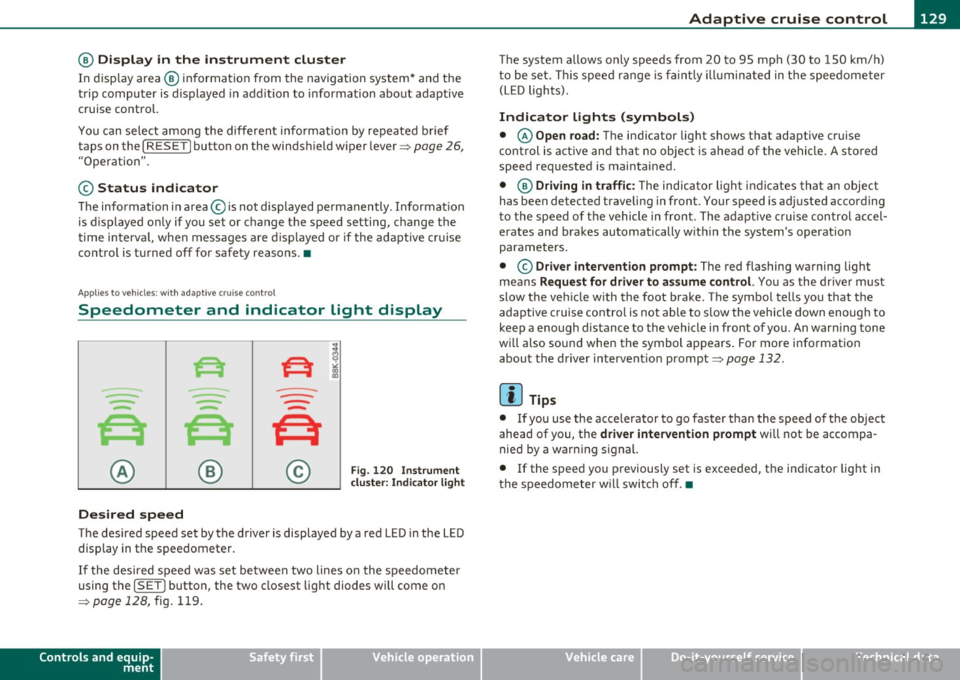
____________________________________________ A_ d_ a.._p _t_ i_ v _e_ c_r_u _ i_ s _e_ c_o_ n_ t_r _o _l __ _
@ Display in the instrument cluster
In disp lay area @ information from the navi gation system * and the
tr ip computer is displayed in add it ion to informa tion about adaptive
c ruise contro l.
You can sele ct among the differe nt info rmatio n by repeated b rief
taps on the
I RESET! button on the winds hield w iper lever => page 26,
"Operat io n".
© Status indicator
Th e info rmation i n area © is no t disp layed per manently. Infor mat ion
is d isplayed o nly if yo u set or c hange the speed setting, change the
ti me in terva l, when messages a re displayed or if the ad apt ive cru ise
cont rol is turned off for safety reasons. •
Appli es to vehicles : w ith a daptive cruise c on tro l
Speedometer and indicator light display
----
- -
- -
@ ®
Desired speed
- -
--
Fig . 120 I nstru ment
cl uste r: Indicator light
T he desired speed set by the driver is displayed by a red LED in the LED
disp lay in the spee dometer.
If the desi red s peed was set be twee n two lines o n the speedo mete r
using the
[ SET J button, the two closest light diodes will come on
=>
page 12 8, fig. 119.
Controls and equip
ment Safety first
T
he system allows only speeds from 20 to 95 mph (30 to 150 km/ h)
t o be se t. T his spee d range is f aint ly ill um inat ed in t he s pee dome ter
(LED lights) .
Indicator lights (symbols)
• © Open road: The indicator light shows t hat adaptive cruise
co ntrol is a ctive and t hat no objec t is ahe ad of the vehi cle. A sto red
speed req uested is maintained.
• @
Driving in traffic : The indicator l igh t ind icates th at an object
has been detected traveling in front . Your speed is ad justed according
t o the spee d of t he vehicle in front. The adaptive c ruise con trol accel
erates and bra kes au tomatically w it hin the system's operat io n
parame ters.
• ©
Driver intervention prompt : The red flashing warning light
me ans
Request for driver to as sume control. You as the drive r m ust
slow t he ve hicle w ith the foot brake . The symbo l tells yo u that the
adaptive cruise contro l is not able to s low the vehicle down enough to
keep a enough distance to the vehicle in front o f you. An war ning tone
wi ll also so und when the symbol ap pears. Fo r more informat ion
abou t the driver intervent ion prompt=>
page 132 .
W Tips
• If you use the ac cele rator to go fa ster than the speed of the object
ahead of you, the
driver intervention prompt will not be accompa
nied by a war ning signal.
• If the speed you p reviously set is exceeded, the ind icator light in
t he s peedometer w ill swit ch off .•
Vehicle care Technical data
Page 132 of 362

ffl..__A_ d_a_ p,__ t_iv _ e_ c_r _ u _i _ s _e _ c_o _n _ t_ r_ o_ l ___________________________________________ _
Applie s to vehicles : w ith a daptiv e cr uise co ntrol
Display in the instrument cluster
Fig. 121 Disp la y in
the instrum ent clu ster
Scroll throug h the available information displays by briefly tapping
the
[ RESE T] button at the end of the windshie ld wiper lever . You can
select information from the tr ip computer, navigation sys tem * or
adaptive cruise contro l.
@ Vehicle symbol
@ Distance
© Status
© Vehicle symbol
Th e veh icle symbol i ndicates w hether the sys tem has de te ct ed an
object traveling in front .
• Vehicle outline : Open road, no vehicle ahead .
• White v ehicl e: A vehicle is detected ahead.
• Red vehicle : Request for driver to ass ume control.
® Distance
Us ing the a rrows and scale, you can detect how far it is to the vehi cle
in front of you.
• Open road : No arrow appears when the ve hicle is o n an o pen road
and there is no ve hicle ahead.
• Driving in t raffic : If a vehicle is detected ahead, the arrow moves
on t he sc ale. The g ree n area represents the distan ce set . When
approaching slow ly, the arrow moves from the
gray zone to the green
zone on the scale .
• Request for driver to as sume control: When approach ing rapidly,
the arrow serves as an early warning signal. If the distance selected is
exceeded or poss ibly no t reached, t he arrow moves in to the
red z o ne
on the scale. In certain driving s ituations , you as the driver wi ll have
t o take action =>
page 132, "Driver in tervent io n prompt".
@ Status
• T he text ACC OFF appea rs in w hite le tters whe n ad apt ive cr uise
control is turned off.
• T he text
ACC AVAILABLE appears in wh ite lette rs when the
system is turned on but no desired speed has been set .
• T he text
OVERRIDE appears in white letters when you exceed the
desired speed by accelerating .
• T he text
DISTANCE! appears in red letters when the interval to a
vehicle traveling ahead is too short and you have to slow your vehicle
add itionally with the foot brake .
• T he te xt messages
DISTANCE 1 to DISTANCE 4 appea r in green
letters to indicate the time i nterval you have set and adaptive cruise
control is in manageme nt mode .
• If the driving program "standard" is replaced by "comfort" or
"dynam ic" using the MM I*, t he above text message is s upplemented
by an appropriate prompt, e .g .
DISTANCE 1 DYN . •
Page 133 of 362
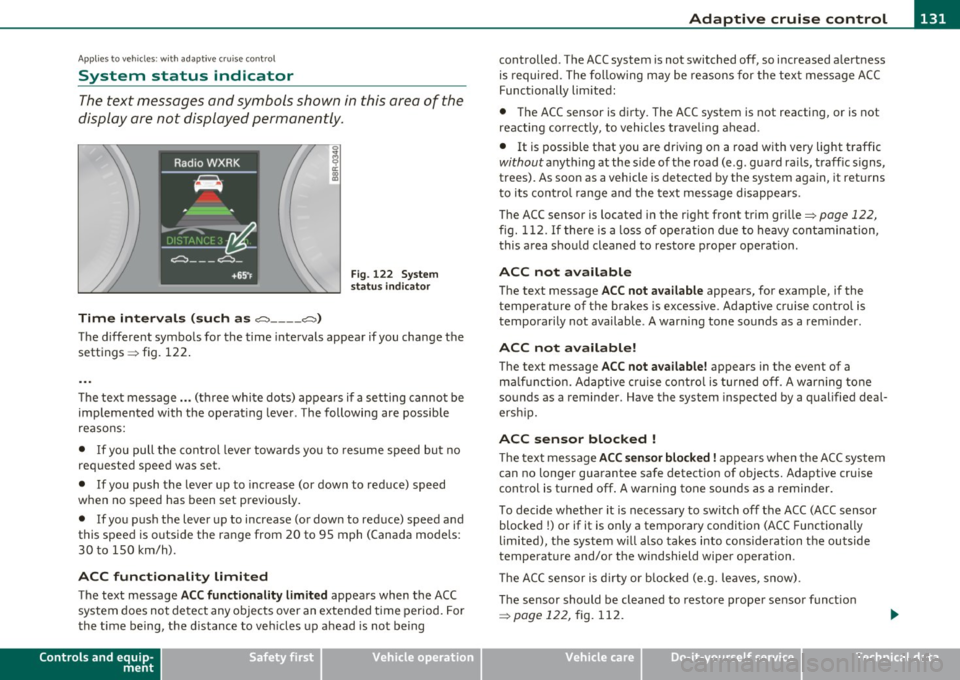
Adaptive cruise control -____________ __,:_ __ _
Appli es to ve hicl es: wi th a daptive cruise cont rol
System status indicator
The text messages and symbols shown in this area of the
display are not displayed permanently .
Time intervals (such as e::::, ____ e::::,)
Fig. 122 System
status indicator
The different symbols for the time intervals appear if you change the
sett ings => fig. 122 .
Th e text message ... (three white dots) appears if a setting cannot be
implemented with the operating lever. The following are possible
reasons:
• If you pull the control lever towa rds you to resume speed but no
requested speed was set .
• If you push the lever up to increase (or down to reduce) speed
when no speed has been set previously.
• If you push the lever up to increase (or down to reduce) speed and
this speed is outside the range from 20 to 95 mph (Canada mode ls:
30 to 150 km/h) .
ACC functionality Limited
The text message ACC functionality limited appears when the ACC
system does not detect any objects over an extended time period. For
the time being, the distance to veh icles up ahead is not being
Controls and equip
ment Safety first
controlled
. The ACC system is not switched off, so increased alertness
is required. The following may be reasons for the text message ACC
Functionally limited:
• The ACC sensor is dirty. The ACC system is not reacting, or is not
reacting correctly, to vehicles traveling ahead.
• It is possible that you are driving on a road with very light traffic
without anything at the s ide of the road (e .g . guard rails, traff ic s igns,
trees). As soon as a vehicle is detected by the system again, it returns
t o its contro l range and the text message disappears.
The ACC sensor is located in the r ight front trim grille=>
page 122,
fig. 112. If there is a loss of operation due to heavy contamination,
this area should cleaned to restore proper operat ion .
ACC not available
The text message ACC not available appears, for examp le, if the
t empe rature of the brakes is excessive. Adaptive cruise control is
temporarily not available. A warning tone sounds as a rem inder .
ACC not available!
The text message ACC not available! appears in the event of a
ma lf unct ion. Adaptive cruise control is turned off. A warn ing tone
sounds as a reminder . Have the system inspected by a qualified deal
ersh ip.
ACC sensor blocked !
The text message ACC sensor blocked! appears when the ACC system
can no longer guarantee safe detection of objects. Adaptive cruise
control is turned off. A warning tone sounds as a reminder.
To decide whether it is necessary to switch off the ACC (ACC sensor
blocked
!) or if it is only a temporary condition (ACC Functionally
limited), the system w ill also takes into consideration the outside
temperature and/or the windshield wiper operation .
Th e ACC sensor is d irty or blocked (e.g. leaves, snow).
The sensor should be cleaned to restore prope r sensor funct ion
=>
page 122, fig. 112.
Vehicle care Technical data
Page 134 of 362
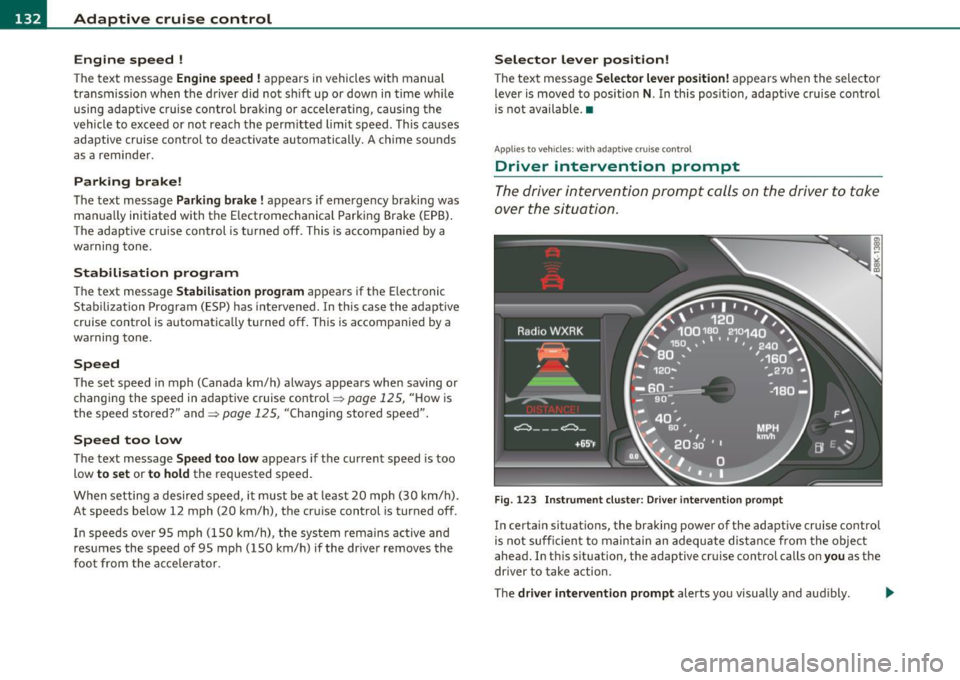
Ill Adaptive cruise control ..__..,___ _____________ _
Engine speed !
The text message Engine speed ! appears in vehicles with manual
transmission when the driver did not shift up or down in time while
using adaptive cruise control braking or accelerating, causing the
vehicle to exceed or not reach the permitted limit speed. This causes
adaptive cruise control to deactivate automatically. A chime sounds
as a reminder .
Parking brake!
The text message Parking brake! appears if emergency braking was
manually initiated with the Electromechanical Parking Brake (EPB).
The adaptive cruise control is turned off . This is accompanied by a
warning tone.
Stabilisation program
The text message Stabilisation program appears if the Electronic
Stab ilizat ion Program (ESP) has inter vened. In this case the adaptive
cruise control is automatically turned off. This is accompanied by a
warning tone.
Speed
The set speed in mph (Canada km/h) always appears when saving or
changing the speed in adaptive cruise control~
page 125, "How is
the speed stored?" and~
page 125, "Chang ing stored speed".
Speed too low
The text message Speed too low appears if the current speed is too
low
to set or to hold the requested speed.
When setting a desired speed, it must be at least 20 mph (30 km/h).
At speeds be low 12 mph (20 km/h), the cruise control is turned off.
In speeds over 95 mph (150 km/h), the system remains active and
resumes the speed of 95 mph (150 km/h) if the driver removes the
foot from the acce lerator .
Selector lever position!
The text message Selector lever position! appears when the selector
lever is moved to position
N. In this position, adaptive cruise control
is not available. •
Appli es to veh icles : w ith a daptive cr uise c ontro l
Driver intervention prompt
The driver intervention prompt calls on the driver to take
over the situation.
Fig. 123 Instrument cluster: Driver intervention prompt
In certain situations, the braking power of the adaptive cruise control
is not sufficient to maintain an adequate distance from the object
ahead. In this situation, the adaptive cruise control calls on
you as the
driver to take action.
The
driver intervention prompt alerts you visually and audibly. -.,
Page 135 of 362
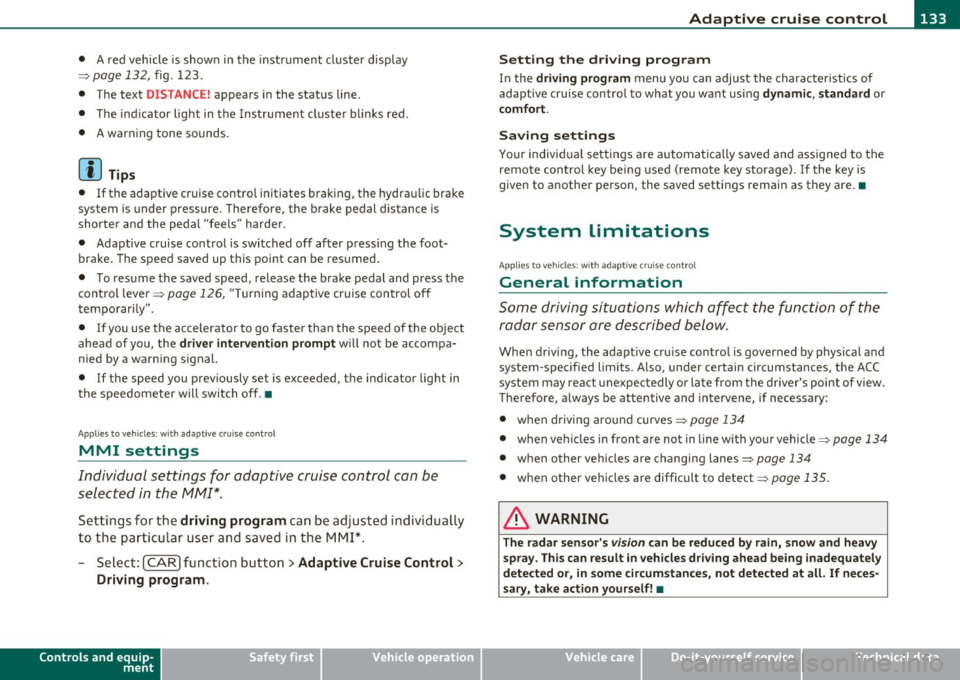
Adaptive cruise control ml ____________ __._ __ _
• A red vehicle is shown in the instrument cluster display
=>
page 132, fig. 123.
• The text
DISTANCE! appears in the status line .
• The indicator light in the Instrument cluster blinks red .
• A warning tone sounds.
[I) Tips
• If the adaptive cruise control initiates brak ing, the hydraulic brake
system is under pressure . Therefore, the brake pedal distance is
shorter and the pedal "feels" harder .
• Adaptive cruise control is switched off after press ing the foot
brake . The speed saved up this point can be resumed.
• To resume the saved speed, release the brake pedal and press the
control lever=>
page 126, "Turning adaptive cruise control off
temporarily ".
• If you use the accelerator to go faster than the speed of the object
ahead of you, the
driver intervention prompt will not be accompa
nied by a warn ing signal.
• If the speed you previously set is exceeded, the indicator light in
the speedometer will switch off.•
Applies to ve hicle s: with ad aptive cru ise co ntro l
MMI settings
Individual settings for adaptive cruise control can be
selected in the fv1fv1I*.
Settings for the driving program can be adjusted individually
to the particular user and saved in the MMI*.
- Select: [CAR] function button
> Adaptive Cruise Control >
Driving program .
Controls and equip
ment Safety first
Setting the driving program
In
the driving program menu you can adjust the character istics of
adaptive cru ise control to what you want using
dynamic , standard or
comfort.
Saving settings
Your individual settings are automatica lly saved and assigned to the
remote control key being used (remote key storage) . If the key is
given to another person, the saved settings remain as they are .•
System limitations
App lies to ve hicles : w it h ada ptiv e cr uise cont ro l
General information
Some driving situations which affect the function of the
radar sensor are described below.
When driving, the adaptive cru ise contro l is governed by physical and
system-specified limits. Also, under certain circumstances, the ACC
system may react unexpectedly or late from the driver's point of view.
Therefore, a lways be attentive and intervene, if necessary:
• when driving around curves=>
page 134
• when vehicles in front are not in line with your vehicle=> page 134
• when other ve hicles are changing lanes=> page 134
• when other veh icles are difficult to detect=> page 135.
& WARNING
The radar sensor's vision can be reduced by rain, snow and heavy
spray . This can result in vehicles driving ahead being inadequately
detected or , in some circumstances , not detected at all. If neces
sary, take action yourself!•
Vehicle care Technical data
Page 136 of 362
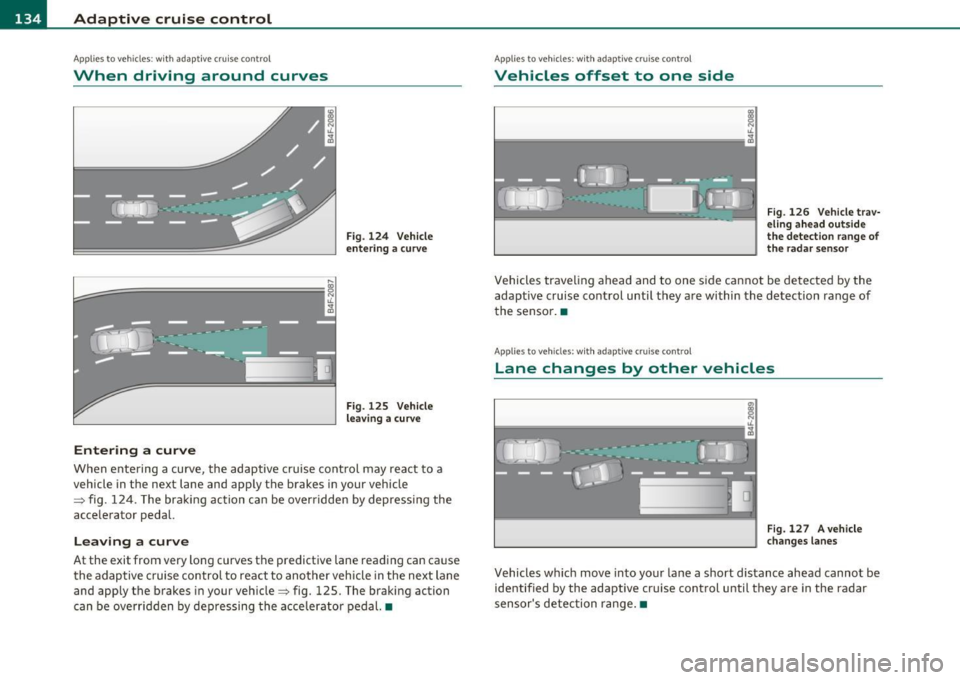
ffl..__A_ d_a_ p ::...... t_iv _ e_ c_r _u _i_ s _e _ c_o _n_ t_ r _o_ l ___________________________________________ _
Applie s to vehicles : w ith a daptiv e cr uise co ntrol
When driving around curves
.....
k;;;;:;;;;;;;;;;:;;:;========= =;J
o!i
.J
Entering a curve
Fig. 124 Vehicle
entering a curve
Fig. 125 Vehicle
leaving a curve
When entering a curve, the adaptive cruise control may react to a
vehicle in the next lane and apply the brakes in your vehicle
=> fig. 124. The braking action can be overridden by depressing the
accelerator pedal.
Leaving a curve
At the exit from very long curves the predictive lane reading can cause
the adap tive cruise control to react to another vehicle in the next lane
and apply the brakes in your vehicle => fig. 125. The braking action
can be overridden by depressing the accelerator pedal.•
Appli es to v eh icles : wi th adaptive cru is e co ntro l
Vehicles offset to one side
Fig. 126 Vehicle trav
eling ahead outside
the detection range of
the radar sensor
Vehicles traveling ahead and to one s ide cannot be detected by the
adaptive cruise control until they are within the detection range of
the sensor. •
Appli es to veh icle s: wit h ad aptiv e cruise cont rol
Lane changes by other vehicles
Fig. 127 A vehicle
changes lanes
Vehicles wh ich move into your lane a short distance ahead cannot be
identified by the adaptive c ruise control until they are in the radar
sensor's detec tion range. •
Page 137 of 362
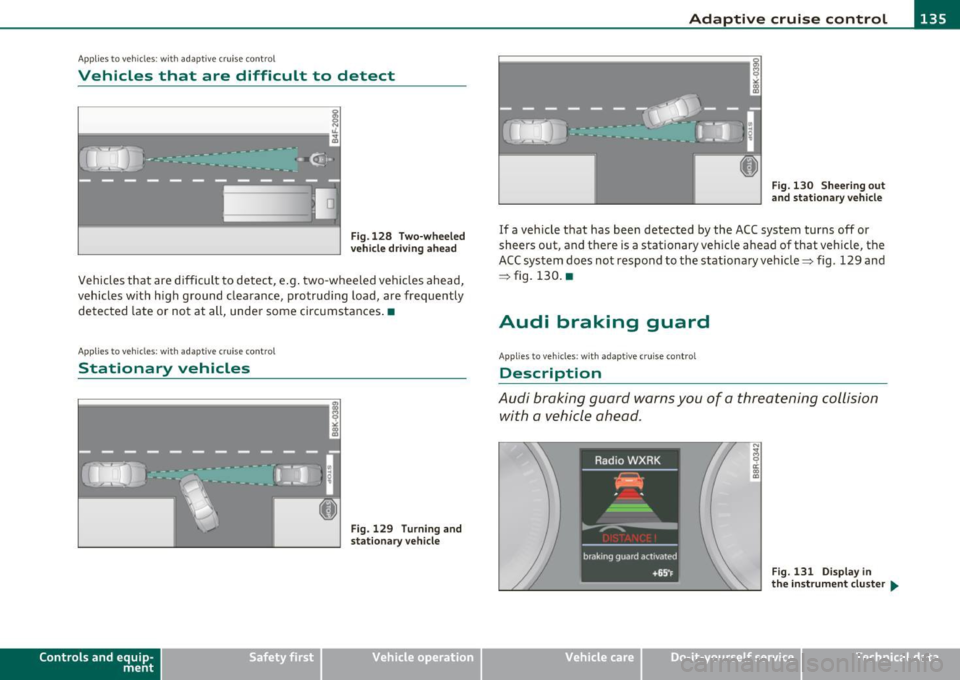
Adaptive cruise control Ill ____________ ____,___ __ ____.
App lies to ve hicles : with a daptiv e cr uise c ontro l
Vehicles that are difficult to detect
OJ
Fig .128 Two-wheeled
vehicle driving ahead
Vehicles that are difficult to detect, e.g . two-wheeled vehicles ahead,
vehicles with h igh ground clearance, protrud ing load, are frequently
detected late or not at all, under some circumstances .•
A ppli es to ve hicl es: with ad apti ve c rui se cont rol
Stationary vehicles
ij - .--......i:;1 ... _;1,,1
Contro ls a nd e quip
m en t
u
Fig. 129 Turning and
stationary ve hicle
Vehicle OP-eration
Fig. 130 Sheering out
and stationary vehicle
If a vehicle that has been detected by the ACC system turns off or
sheers out, and there is a stationary veh icle ahead of that vehicle, the
ACC system does not respond to the stationary vehicle=> fig. 129 and
=> fig. 130. •
Audi braking guard
Applies to ve hicles: w ith ada ptiv e cr uise con trol
Description
Audi braking guard warns you of a threatening collision
with a vehicle ahead .
N
I
Fig. 131 Display in
the in strum ent cluster ...
Vehicle care Do-it-yourselt service iTechnical data
Page 138 of 362
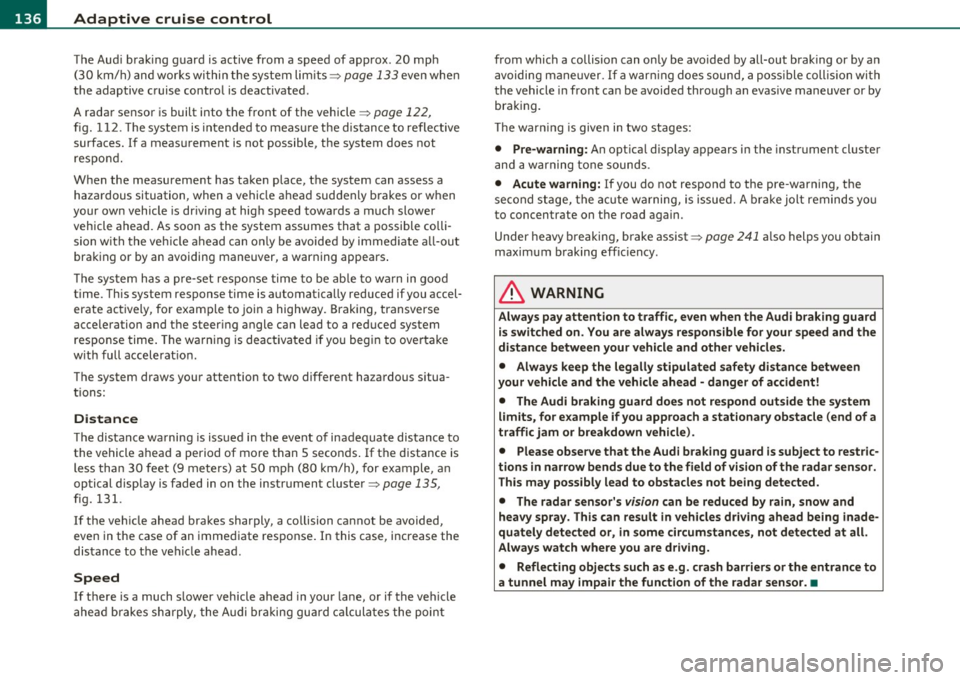
IIII.___A_ d_ a,.:.p _ t_ i _v _ e_ c_ r _u _ is_ e_ c_o _n_ t_r _o _l _____________________________________________ _
The Audi braking guard is active from a speed of approx. 20 mph
(30 km/h) and works within the system limits=>
page 133 even when
the adaptive cruise control is deactivated.
A radar sensor is built into the front of the vehicle=>
page 122,
fig. 112. The system is intended to measure the distance to reflective
surfaces. If a measurement is not possible, the system does not
respond.
When the measurement has taken place, the system can assess a
hazardous situation, when a vehicle ahead suddenly brakes or when
your own vehicle is dr iving at high speed towards a much slower
vehicle ahead. As soon as the system assumes that a possible colli
sion w ith the vehicle ahead can only be avoided by immediate all-out
braking or by an avoiding maneuver, a warning appears .
Th e system has a pre-set response time to be able to warn in good
time. This system response time is automatically reduced if you accel
erate actively, for example to join a highway. Braking, transverse
acceleration and the steering angle can lead to a reduced system
response time. The warning is deactivated if you begin to overtake
with full accelerat ion.
The system draws your attention to two different hazardous situa
tions:
Distance
Th e distance wa rning is issued in the event of inadequate distance to
the vehicle ahead a period of more than S seconds. If the distance is
less than 30 feet (9 meters) at SO mph (80 km/h), for example, an
optical display is faded in on the instrument cluster=>
page 135,
fig. 131.
If the vehicle ahead brakes sharply, a collision cannot be avoided,
even in the case of an immediate response. In this case, increase the
distance to the vehicle ahead.
Speed
If there is a much slower vehicle ahead in your lane, or if the vehicle
ahead brakes sha rply, the Audi braking guard calculates the point from which a collision can only be avoided by all-out brak
ing or by an
avoiding maneuver. If a warning does sound, a possible collision with
the vehicle in front can be avoided through an evasive maneuver or by
braking.
Th e warn ing is given in two stages:
• Pre-warning: An optical display appears in the instrument cluster
and a warning tone sounds.
• Acute warning: If you do not respond to the pre-warning, the
second stage, the acute warning, is issued. A brake jolt reminds you
to concentrate on the road again.
Under heavy breaking, brake assist =>
page 241 also helps you obtain
maximum braking effic ien cy.
& WARNING
Always pay attention to traffic, even when the Audi braking guard
is switched on. You are always resp onsible for
your speed and the
distance between your vehicle and other vehicles.
• Always keep the legally stipulated safety distance between
your vehicle and the vehicle ahead -danger of accident!
• The Audi braking guard does not respond outside the system
limits, for example if you approach a stationary obstacle (end of a
traffic jam or breakdown vehicle).
• Please observe that the Audi braking guard is subject to restric
tions in narrow bends due to the field of vision of the radar sensor.
This may possibly lead to obstacles not being detected.
• The radar sensor's
vision can be reduced by rain, snow and
heavy spray . This can result in vehicles driving ahead being inade
quately detected or, in some circumstances, not detected at all.
Always watch where you are driving.
• Reflecting objects such as e.g. crash barriers or the entrance to
a tunnel may impair the function of the radar sensor.•
Page 139 of 362
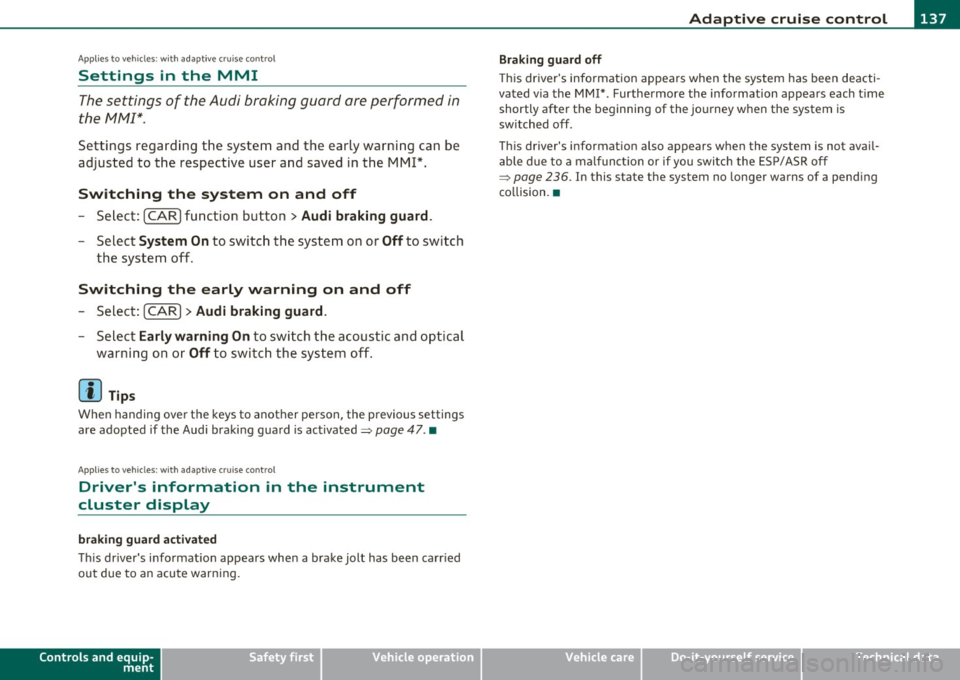
____________________________________________ A_ d_ a.._p _t_ i_ v _e_ c_r_u _ i_ s _e_ c_o_ n_ t_r _o _l __ ffl'II
A pp lies to ve hicl es: wi th a daptive cruise co ntro l
Settings in the MMI
The settings of the Audi braking guard are performed in
the MMI* .
Settings regarding the system and the early warning can be
adjusted to the respective user and saved in the MM!*.
Switching the system on and off
-Select: [ CAR] function button > Audi braking guard .
-Select System On to switch the system on or Off to switch
the system off .
Switching the early warning on and off
-Select: [CAR]> Audi braking guard.
-Select Early warning On to switch the acoustic and optical
warning on or Off to switch the system off.
[I] Tips
When handing over the keys to another person, the previous settings
are adopted if the Audi braking guard is activated=>
page 47 . •
A pplie s to v ehicl es: w ith adaptiv e c rui se co ntro l
Driver's information in the instrument
cluster display
braking guard activated
This driver's informat ion appears when a brake jolt has been carr ied
out due to an acute warning.
Controls and equip
ment Safety first Braking guard
off
This driver's information appears when the system has been deacti
vated v ia the
MMI* . Furthermore the information appears each time
shortly after the beginning of the journey when the system is
switched off .
This driver's information also appears when the system is not ava il
able due to a malfunction or if you switch the ESP/ ASR off
=>
page 236 . In this s tate the system no longer warns of a pend ing
collision. •
Vehicle care Technical data
Page 140 of 362
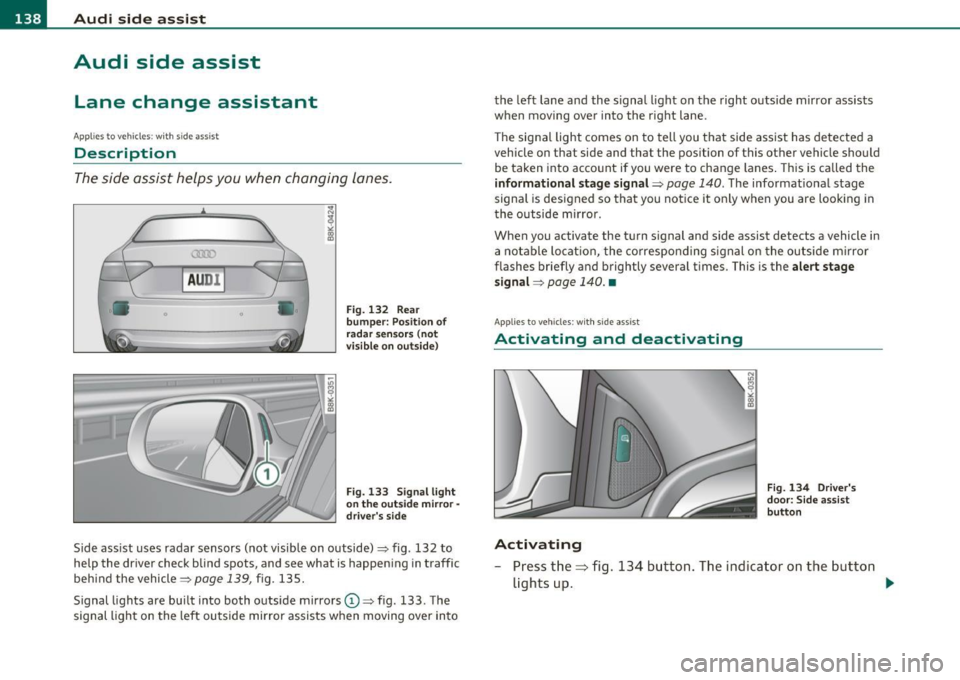
llffl..__A_ u_ d_ i_ s_ i_ d_ e _ a_ s_s _i_s _t _________________________________________________ _
Audi side assist
Lane change assistant
Applies to veh icles : w ith s ide ass ist
Description
The side assist helps you when changing lanes.
A UD I
0
•
Fig . 1 32 Rear
bu mper: Position of
r a d ar s ensors ( not
v isible on ou ts ide)
Fig. 133 Signal light
o n the out side m ir ror -
driv er's s id e
Side ass ist uses radar sensors (not vi sible on outside)=> fig. 132 to
help the driver check blind spots , and see what is happen ing in traffic
behind the vehicle=>
page 139, fig. 135.
Signal lights are bu ilt into both outside mirrors
(D => fig . 133 . The
signal ligh t on the left ou tside mirror assists when moving over in to the
left lane and the signal light on the right outs ide mirror assists
when moving over into the right lane.
T he sig nal light comes on to tell you that side assist has detected a
vehicle on that side and that the position of this other vehicle should be taken into acco unt if you were to change lanes . This is called the
inf ormational stage signal =>
page 140. The informationa l stage
signal is designed so that you not ice it only when you are looking in
the o utside m irror.
When you activate the turn s ignal and side assist detects a vehicle in
a notable locat io n, the co rrespo nd ing s ignal on the ou tside m irror
flashes briefly and brightly several times. This is the alert stage
s ignal =>
page 140. •
Applies t o vehicle s: wit h sid e ass ist
Activating and deactivating
Activating
Fig. 134 Dr ive r's
do or: S ide assist
bu tto n
- Press the=> fig. 134 button . The indicator on the but ton
lights up . .,_